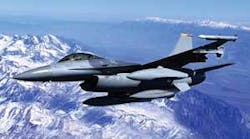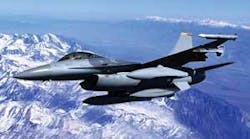ITT flies electronic warfare system on Chilean F-16 jet fighter
By John McHale
WHITE PLAINS, N.Y. - ITT’s Electronic Systems’s ALQ-211 Electronic Warfare suite is providing electronic countermeasures and other capabilities for Chilean F-16s.
The ALQ-211 (V)4 system, the first fielded with programmable, digital radar warning receiver architecture, has been installed and integrated aboard all 10 Peace Puma F-16s delivered to Chile. Work on the program is being performed by ITT’s Electronic Systems Division in White Plains, N.Y.
“This integrated radar warning receiver/jammer, with its dual receiver architecture is the first new tactical EW [electronic warfare] system for fighter applications in years,” says Electronic Systems President Chris Bernhardt. “This new digital technology results in more effective defense against threats to warfighters.”
The ALQ-211 (V)4, the Advanced Integrated Defensive EW Suite (AIDEWS), successfully completed the required safety of flight, systems integration lab, and electromagnetic interference tests last year. Integration flight tests for the Chilean aircraft were successfully performed at Edwards Air Force Base, Calif., and the China Lake Electronic Warfare Range, Calif., this summer.
AIDEWS, an integrated EW countermeasure system, provides today’s fighter pilot with situational awareness and protection against radar-based threats, including modern surface-to-air and air-to-air weapon systems. It is built upon the proven ALQ-211 family of EW Systems now being used to support U.S. Special Operations forces.
This version of the ALQ-211 utilizes advanced wideband and digital receivers to quickly and accurately detect and identify several, complex emitters when operating in today’s high-density threat environment, says Henry Bourne, director of ITT’s Rotary Wing EW business area. AIDEWS provides protection using a highly flexible, programmable technique generator that transmits deceptive countermeasure signals and coordinates use of chaff and flares.
The ALQ-211 not the pilot to foil radar threats by seeing the radar before it sees him, says John Dench, director of marketing for ITT Electronic Systems.
ITT’s modular system approach is less expensive and has the flexibility to deal with threats as they evolve, Dench says. The modularity also helps manage obsolescence issues, Dench adds.
ITT’s special operations work is part of a three-year contract from the U.S. Army’s Technology Applications Program Office in Fort Eustis, Va., to produce electronic warfare systems for Special Operations Army helicopters. Contract work is performed by ITT’s Avionics division in Clifton, NJ.
Under the contract, ITT will supply ALQ-211 electronic warfare systems to the Army, with deliveries continuing until 2008. The ALQ-211 family of SIRFC systems plays an important role in mission success and survivability of rotary wing aircraft. This next-generation electronic protection suite provides advanced radar warning, situational awareness, and electronic countermeasures capabilities. SIRFC will allow aircrews to detect, evade and defeat modern and emerging air defense threats.
ITT’s EW suites are on the U.S. Army’s MH 47 and MH 60 Blackhawk helicopters, Dench says.
ITT Electronic Systems is a leading supplier of information and electronic warfare (EW) technologies, systems, and services for a broad range of military aircraft. Its Gilfillan radar systems provide state-of-the-art air defense, surveillance, multifunction and air traffic control radar systems for U.S. and international land and maritime applications.
For more information, visit www.itt.com.

